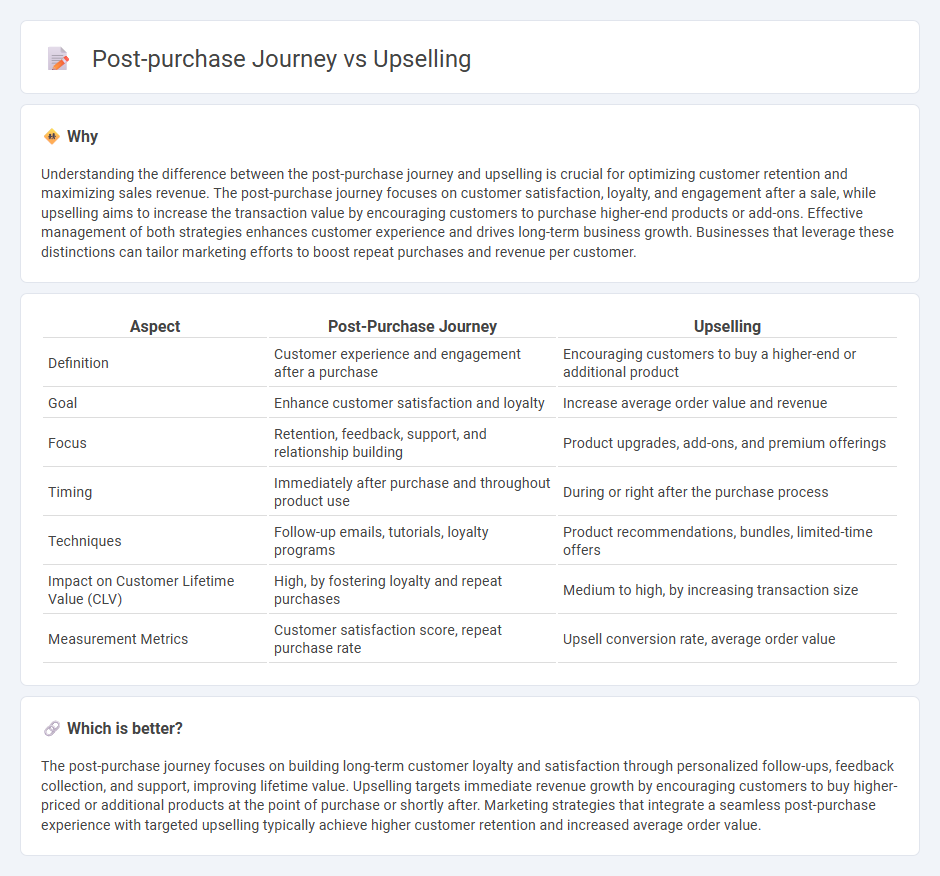
Post-purchase journey focuses on nurturing customer satisfaction and loyalty through personalized experiences and timely support, while upselling aims to increase revenue by offering enhanced or complementary products at the point of purchase or after. Effective post-purchase strategies identify key moments to introduce upselling opportunities, enhancing customer lifetime value without compromising trust. Discover how integrating post-purchase engagement with targeted upselling can drive sustainable business growth.
Why it is important
Understanding the difference between the post-purchase journey and upselling is crucial for optimizing customer retention and maximizing sales revenue. The post-purchase journey focuses on customer satisfaction, loyalty, and engagement after a sale, while upselling aims to increase the transaction value by encouraging customers to purchase higher-end products or add-ons. Effective management of both strategies enhances customer experience and drives long-term business growth. Businesses that leverage these distinctions can tailor marketing efforts to boost repeat purchases and revenue per customer.
Comparison Table
| Aspect | Post-Purchase Journey | Upselling |
|---|---|---|
| Definition | Customer experience and engagement after a purchase | Encouraging customers to buy a higher-end or additional product |
| Goal | Enhance customer satisfaction and loyalty | Increase average order value and revenue |
| Focus | Retention, feedback, support, and relationship building | Product upgrades, add-ons, and premium offerings |
| Timing | Immediately after purchase and throughout product use | During or right after the purchase process |
| Techniques | Follow-up emails, tutorials, loyalty programs | Product recommendations, bundles, limited-time offers |
| Impact on Customer Lifetime Value (CLV) | High, by fostering loyalty and repeat purchases | Medium to high, by increasing transaction size |
| Measurement Metrics | Customer satisfaction score, repeat purchase rate | Upsell conversion rate, average order value |
Which is better?
The post-purchase journey focuses on building long-term customer loyalty and satisfaction through personalized follow-ups, feedback collection, and support, improving lifetime value. Upselling targets immediate revenue growth by encouraging customers to buy higher-priced or additional products at the point of purchase or shortly after. Marketing strategies that integrate a seamless post-purchase experience with targeted upselling typically achieve higher customer retention and increased average order value.
Connection
The post-purchase journey plays a critical role in identifying opportunities for upselling by analyzing customer satisfaction and engagement after the initial sale. By leveraging data from post-purchase interactions, marketers can personalize upsell offers tailored to customer preferences, increasing conversion rates and customer lifetime value. Effective post-purchase communication strengthens brand loyalty, creating a receptive environment for upselling high-value products or services.
Key Terms
Cross-Sell
Upselling aims to increase transaction value by encouraging customers to purchase a higher-end product or add-ons during the buying process, while the post-purchase journey centers on maintaining engagement and satisfaction after the sale is complete. Cross-sell strategies during the post-purchase phase recommend complementary products tailored to the customer's original purchase, enhancing lifetime value and brand loyalty. Explore how integrating cross-sell techniques within the post-purchase journey can amplify revenue and deepen customer relationships.
Customer Retention
Upselling during the post-purchase journey enhances customer retention by offering tailored product recommendations that increase lifetime value and satisfaction. By analyzing purchase behavior and engagement metrics, brands can deliver personalized experiences that foster loyalty and repeat business. Explore effective strategies to optimize upselling and strengthen your customer retention efforts.
Order Value
Upselling targets increasing average order value by encouraging customers to purchase higher-end products or add-ons during the buying process, leveraging moments of high purchase intent. The post-purchase journey focuses on customer retention and lifetime value through personalized follow-ups, cross-sells, and loyalty programs designed to maximize future order value. Explore strategies to effectively boost order value at every stage of the customer lifecycle.
Source and External Links
Upselling - Wikipedia - Upselling is a sales technique where a seller invites the customer to purchase more expensive items, upgrades, or other add-ons to generate more revenue, distinct from cross-selling which offers different products, and often involves tactics like creating urgency or tailoring offers to customer needs.
How To Upsell: 15 Upselling Tips & Examples To Boost Revenue - Upselling is suggesting a better or more expensive version of a product or service to a customer already interested in buying, aiming to increase the sale's value and customer lifetime value by offering relevant upgrades or premium options.
What Is Upselling? Definition, Examples, & Expert Tips - Plaky - Upselling involves offering higher-end or upgraded products by understanding customer needs and pain points, increasing sales revenue, boosting retention, and enhancing brand reputation, differentiating it from cross-selling, which promotes complementary products.
 dowidth.com
dowidth.com